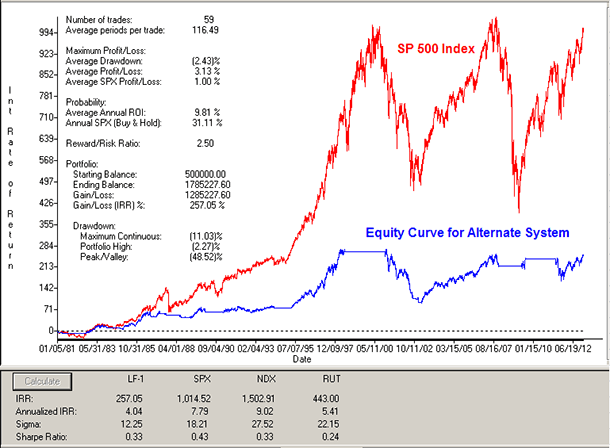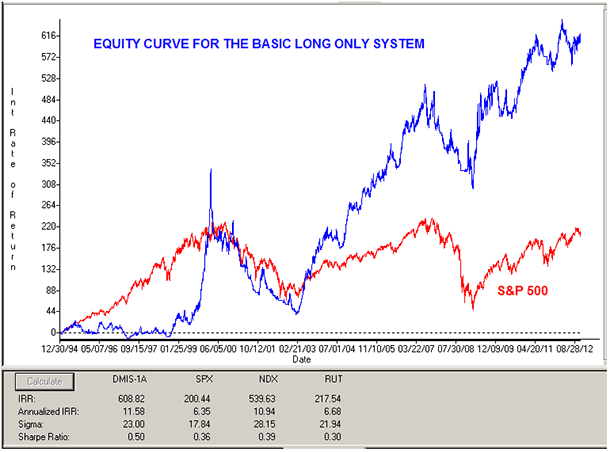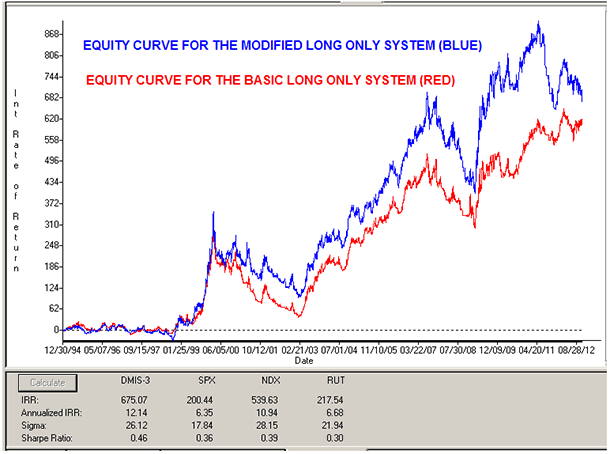|
by Hank Swiencinski, AIQ TradingExpert Pro client for over 20 years, founder of ‘The Professor’s One Minute Guide to Stock Management’.
AIQ will be hosting a full day seminar with ‘The Professor’, March 9, 2013 in Orlando, FL. More info CLICK HERE
The Dow started the week at 13,992. On Friday, it closed at 13,981 for a weekly gain of 11 points. Three weeks ago, the Dow was trading at 13,895. So for the past three weeks, the Dow has been in a trading range of about 100 points. This won’t last!
Trading ranges are consolidation areas, where the market takes a breather. When the market breaks out of a trading range, it usually does so in the direction it enters the trading range. And in this case, the direction was up. Trading ranges form the Blades of our Hockey Stick Pattern and act as compressed springs to propel prices higher. They give stocks the energy to hit their targets.
During its three-week consolidation, the Dow has remained in an Up trend. All of the PT indicators remain positive.
The Dean’s List remains long, strong and positive. And the Coach (Money Flow) was especially strong on Friday.
But there is one thing that happened on Friday that should be noted. The 2-period RSI Wilder on the Dow (DIA) finally became oversold. It finished the day with a reading of 14.91. Hmmm?
As you learned in Class, whenever a stock is in an Up trend, with all of the PT indicators positive, and the 2-period RSI Wilder pulls back into oversold territory (below 30) it’s time to get out the rifle and go hunting. In this case, because it’s the Dow (DIA) it’s more like time to bring out the shotgun…or a cannon!. There could be lots of things to shoot!
The same conditions exist on the Nasdaq, where the 2-period RSI Wilder on the QQQ finished the week with an oversold reading of 26.28. The SPY did not finish oversold as it remains in a strong up trend.
So what to do?
Assuming that what we have been seeing for the past 3 weeks is the development of a wave 4 consolidation Blade, there is a good chance that the market will start to move higher next week. And given that both the Dow and Nasdaq are currently oversold, they might be the best places to look for bargains. So that’s where I’m gonna start with my shopping list.
One obvious place to look is the indexes themselves, with DIA (hand grenade) and DDM (atom bomb). If the Dow starts to move higher, both should do nicely. Same for the QQQ and QLD if the Nasdaq comes to life.
Right now, Emeritus is only highlighting two stocks for the Honor Roll, PFE and AGN. From the feedback I received during the week, some of his stocks were very good to many of you. However as we have seen in the past, Honor Roll stocks not only tend to give us an initial pop, especially when they have tight Bands, but they tend to perform well even after being triggered. Remember, CNI caught my eye back in early January by being an Honor Roll stock. So all of the stocks that were listed this past week remain in play. Stocks like GE and HPQ are Dow components. CVX and XOM are the two energy components of the Dow. PFE, one of the stocks currently being highlighted by Emeritus, is also a Dow component.
IBM is another Dow component with an interesting Pattern. The stock popped 8.6 points reaching a high of 208.58 on 20 January, and has been pulling back ever since. The January pop was a ‘rope jump’, meaning that the current pullback could be a wave 2. IBM is currently RED on the 60s. It should be watched IF it turns GREEN, especially if it starts to move above 202.09.
Many of you had a lot of fun with SLB on Thursday, but as expected, the stock pulled back on Friday. It’s not a rifle trade yet, because the 2-period RSI is still not oversold. But IF SLB continues to pull back early next week; you know what I’m doing.
Anyhow, I’m seeing a lot of stocks with attractive patterns. And now, the major indexes appear to be finishing their three-week corrective pattern and have now become oversold.
Big Picture Strategy: It’s time to go hunting. If I’m right, wave 5 up should be starting very soon. If one of your favorite stocks on the MWL has pulled back during the past week or so, you might want to think about adding a few shares. Or IF your favorite stock has moved up during the rally, and you decided to take some or all of your position off the table, this might be a time to re-establish a new position.
The Dean’s List is telling us that a lot of sectors are very strong now. But the energy sector appears to be the strongest. Energy related ETFs currently represent 4 out of the top 7 on the List. So I need to be thinking about energy. But I’m not interested in all energy stocks now. Just the ones with nice Blades. I’m looking for stocks that have risen with the market, and have taken a breather. Stocks with low RSIs like HERO (29.09), MRO (31.94) and ATW (34.18).
All are rifle trades on the 60s.
On a different energy tack, you might consider something like uranium miner, CCJ, which has a beautiful HS Pattern in place. China alone has 16 nuclear power reactors in operation, with 30 more under construction. They currently plan a 5-6-fold increase in nuclear capacity by 2020. And even though construction of new plants in the US has been on a 30-year hold, 45 new countries are either constructing or have plans to construct nuclear power plants in the near future. They are going to have to get their uranium from somewhere. CCJ is on MWL, and has quietly started an Up trend three days ago when the 50 moved above the 200. It has a recent Blade high of 22.05. On Friday, it closed at 21.61. If it moves above 22.05, I’m a buyer.
Have a great weekend and remember to polish up that rifle.
That’s what I’m doing,
h
|



